The Plextor M3 (256GB) Review
by Kristian Vättö on April 5, 2012 3:05 AM ESTAnandTech Storage Bench 2011
Last year we introduced our AnandTech Storage Bench, a suite of benchmarks that took traces of real OS/application usage and played them back in a repeatable manner. Anand assembled the traces out of frustration with the majority of what we have today in terms of SSD benchmarks.
Although the AnandTech Storage Bench tests did a good job of characterizing SSD performance, they weren't stressful enough. All of the tests performed less than 10GB of reads/writes and typically involved only 4GB of writes specifically. That's not even enough exceed the spare area on most SSDs. Most canned SSD benchmarks don't even come close to writing a single gigabyte of data, but that doesn't mean that simply writing 4GB is acceptable.
Originally we kept the benchmarks short enough that they wouldn't be a burden to run (~30 minutes) but long enough that they were representative of what a power user might do with their system. Later, however, we created what we refer to as the Mother of All SSD Benchmarks (MOASB). Rather than only writing 4GB of data to the drive, this benchmark writes 106.32GB. This represents the load you'd put on a drive after nearly two weeks of constant usage. And it takes a long time to run.
1) The MOASB, officially called AnandTech Storage Bench 2011—Heavy Workload, mainly focuses on the times when your I/O activity is the highest. There is a lot of downloading and application installing that happens during the course of this test. Our thinking was that it's during application installs, file copies, downloading, and multitasking with all of this that you can really notice performance differences between drives.
2) We tried to cover as many bases as possible with the software incorporated into this test. There's a lot of photo editing in Photoshop, HTML editing in Dreamweaver, web browsing, game playing/level loading (Starcraft II and WoW are both a part of the test), as well as general use stuff (application installing, virus scanning). We included a large amount of email downloading, document creation, and editing as well. To top it all off we even use Visual Studio 2008 to build Chromium during the test.
The test has 2,168,893 read operations and 1,783,447 write operations. The IO breakdown is as follows:
| AnandTech Storage Bench 2011—Heavy Workload IO Breakdown | ||||
| IO Size | % of Total | |||
| 4KB | 28% | |||
| 16KB | 10% | |||
| 32KB | 10% | |||
| 64KB | 4% | |||
Only 42% of all operations are sequential; the rest ranges from pseudo to fully random (with most falling in the pseudo-random category). Average queue depth is 4.625 IOs, with 59% of operations taking place in an IO queue of 1.
Many of you have asked for a better way to really characterize performance. Simply looking at IOPS doesn't really say much. As a result we're going to be presenting Storage Bench 2011 data in a slightly different way. We'll have performance represented as Average MB/s, with higher numbers being better. At the same time we'll be reporting how long the SSD was busy while running this test. These disk busy graphs will show you exactly how much time was shaved off by using a faster drive vs. a slower one during the course of this test. Finally, we will also break out performance into reads, writes, and combined. The reason we do this is to help balance out the fact that this test is unusually write intensive, which can often hide the benefits of a drive with good read performance.
There's also a new light workload for 2011. This is a far more reasonable, typical every day use case benchmark. It has lots of web browsing, photo editing (but with a greater focus on photo consumption), video playback, as well as some application installs and gaming. This test isn't nearly as write intensive as the MOASB but it's still multiple times more write intensive than what we were running last year.
We don't believe that these two benchmarks alone are enough to characterize the performance of a drive, but hopefully along with the rest of our tests they will help provide a better idea. The testbed for Storage Bench 2011 has changed as well. We're now using a Sandy Bridge platform with full 6Gbps support for these tests.
AnandTech Storage Bench 2011—Heavy Workload
We'll start out by looking at average data rate throughout our new heavy workload test:
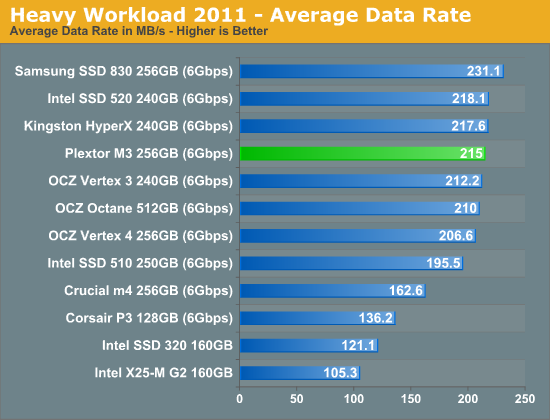
Samsung SSD 830 continues to dominate our Heavy suite but in both read and write, but the M3 is the fastest Marvell based SSD and delivers a result 32% faster than the Crucial m4. Overall the M3 is on-par with SandForce—it does worse in read speed but takes that back in write speed.
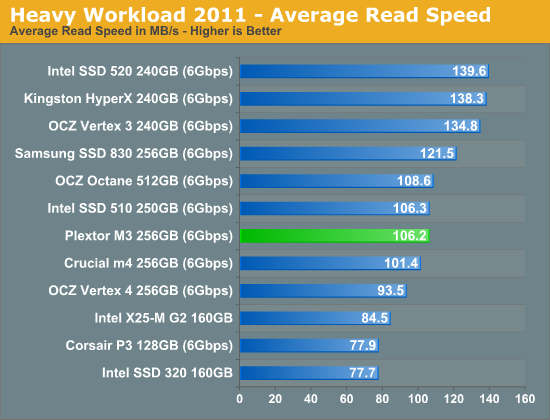
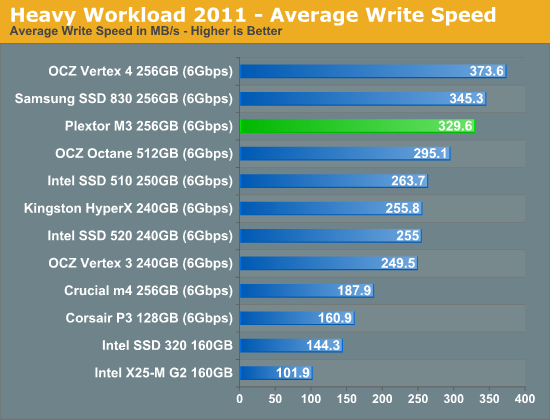
The next three charts just represent the same data, but in a different manner. Instead of looking at average data rate, we're looking at how long the disk was busy for during this entire test. Note that disk busy time excludes any and all idles; this is just how long the SSD was busy doing something:
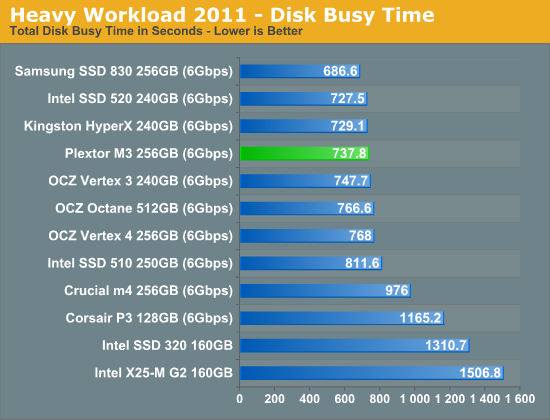
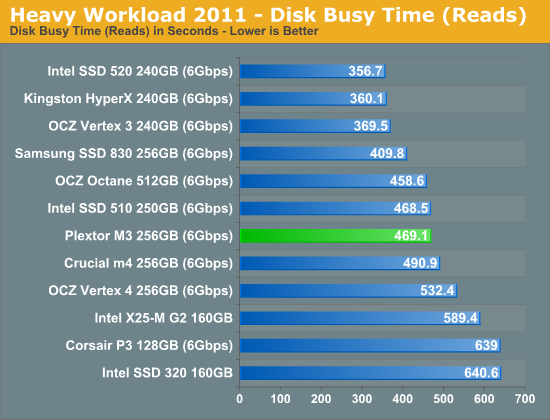
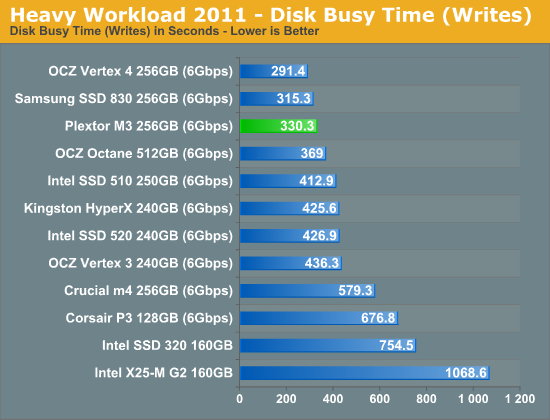










113 Comments
View All Comments
Tor-ErikL - Thursday, April 5, 2012 - link
In europe plextor is one of the pioneers in the IT industry. They where one of the first to enter the cd-burner market way back in the days. They are generally known in europe to produce some of the finest quality products when in comes to cd-burners and back in the days it was the only burner to own ;)Tor-ErikL - Thursday, April 5, 2012 - link
I'm not surprised that they come up with another good quality product here, they have always been more expensive than others but you always get a good quality product from them.Fujikoma - Thursday, April 5, 2012 - link
The last Plextor optical drive I had broke within months. It was very flimsy and the shipping to have it fixed was more than buying a replacment from another vendor that had the same build quality. Plextor's quality isn't any different than other cheap drive manufacturers even though their price is.Maiyr - Thursday, April 5, 2012 - link
I am still using a PleXCombo 20/10/40-12A. My experience in no way mirrors yours. I got this thing and another drive in 2002/2003 and both are still going strong. No problems.Maiyr
hansmuff - Thursday, April 5, 2012 - link
Those were different times.I have two plextor drives:
SCSI UltraPlex 40MAX, the best CD reader ever built.
ATAPI 8/4/32 CD burner. Also a really excellent drive.
Those were "expensive" back then. The ultraplex was $140, the 8/4/32 was ~$90.
After those, drive prices tumbled and Plextor used cheapo OEM drives like everyone else and rebadged them.
Both you and Fukikoma are correct.
vol7ron - Thursday, April 5, 2012 - link
Was going to say something similar.It's like how Seagate has had good drives, but they do have bad batches, especially as they're refining their process.
Quality should not be solely determined on the product. How a company responds to a defective, or poorly made product should extend into the definition of quality. It might not be product quality, but quality of the experience is more important.
Like, I might get a bad part off Newegg, but they have great customer service that make it easy to ship it back and receive a replacement or a refund. I know they're only a middle man in the process, but the tradeoff is having a good product with good customer service, that reduces customer hassle.
Sabresiberian - Saturday, April 7, 2012 - link
The thing that makes me wonder what's going on with your post is the way you describe Plextor's quality as not being better than "any other cheap drive". The fact is, there are near a dozen DVD burner brands that cost less than $25 that are reliable pieces of hardware. They are inexpensive, but they aren't cheap.I'm another person with a Plextor drive that's been around for a couple of builds, and will soon go in a third. Do I think it will outlast my LG drive I bought a couple of years later? No, but Plextor help set reliability and top-notch performance standards that are the reasons we have inexpensive and reliable burners now.
;)
andylawcc - Thursday, April 5, 2012 - link
ditto: Plextor made one of the best CD-Burner back then (talking only about, just late 1990).note to Mr. Vatto: you could have skipped that the line, we wouldn't know. ;p
JarredWalton - Thursday, April 5, 2012 - link
Note to our readers: Kristian is 17. When optical drives mattered (in terms of benchmarks), he would have been about 10.Kristian Vättö - Thursday, April 5, 2012 - link
I'm 18 now and have been for a few months ;-)